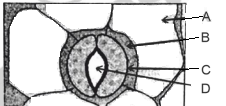
This Page Score: 0/24
The transverse section of a plant shows following
anatomical features:
(a) Large number of scattered vascular bundles
surrounded by bundle sheath.
(b) Large conspicuous parenchymatous ground
tissue.
(c) Vascular bundles conjoint and closed.
(d) Phloem parenchyma absent.
Identify the category of plant and its part:
Which of the statements given below is not true about formation of Annual Rings in trees?
Phloem in gymnosperms lacks:
Bulliform cells are responsible for:
In the given figure, which component has thin outer walls and highly thickened inner walls?

Given below are two statements:
Statement I: Parenchyma is living but collenchyma is dead tissue.
Statement II: Gymnosperms lack xylem vessels but presence of xylem vessels is the characteristic of
angiosperms.
In the light of the above statements, choose the correct answer from the options given below:
This Page Score: 0/24